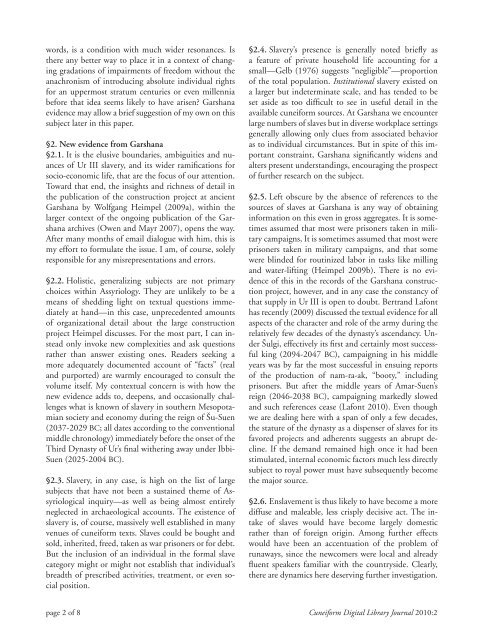Slavery and Freedom in the Third Dynasty of Ur - Cuneiform Digital ...
Slavery and Freedom in the Third Dynasty of Ur - Cuneiform Digital ...
Slavery and Freedom in the Third Dynasty of Ur - Cuneiform Digital ...
You also want an ePaper? Increase the reach of your titles
YUMPU automatically turns print PDFs into web optimized ePapers that Google loves.
words, is a condition with much wider resonances. Is<br />
<strong>the</strong>re any better way to place it <strong>in</strong> a context <strong>of</strong> chang<strong>in</strong>g<br />
gradations <strong>of</strong> impairments <strong>of</strong> freedom without <strong>the</strong><br />
anachronism <strong>of</strong> <strong>in</strong>troduc<strong>in</strong>g absolute <strong>in</strong>dividual rights<br />
for an uppermost stratum centuries or even millennia<br />
before that idea seems likely to have arisen? Garshana<br />
evidence may allow a brief suggestion <strong>of</strong> my own on this<br />
subject later <strong>in</strong> this paper.<br />
§2. New evidence from Garshana<br />
§2.1. It is <strong>the</strong> elusive boundaries, ambiguities <strong>and</strong> nuances<br />
<strong>of</strong> <strong>Ur</strong> III slavery, <strong>and</strong> its wider ramifi cations for<br />
socio-economic life, that are <strong>the</strong> focus <strong>of</strong> our attention.<br />
Toward that end, <strong>the</strong> <strong>in</strong>sights <strong>and</strong> richness <strong>of</strong> detail <strong>in</strong><br />
<strong>the</strong> publication <strong>of</strong> <strong>the</strong> construction project at ancient<br />
Garshana by Wolfgang Heimpel (2009a), with<strong>in</strong> <strong>the</strong><br />
larger context <strong>of</strong> <strong>the</strong> ongo<strong>in</strong>g publication <strong>of</strong> <strong>the</strong> Garshana<br />
archives (Owen <strong>and</strong> Mayr 2007), opens <strong>the</strong> way.<br />
After many months <strong>of</strong> email dialogue with him, this is<br />
my effort to formulate <strong>the</strong> issue. I am, <strong>of</strong> course, solely<br />
responsible for any misrepresentations <strong>and</strong> errors.<br />
§2.2. Holistic, generaliz<strong>in</strong>g subjects are not primary<br />
choices with<strong>in</strong> Assyriology. They are unlikely to be a<br />
means <strong>of</strong> shedd<strong>in</strong>g light on textual questions immediately<br />
at h<strong>and</strong>—<strong>in</strong> this case, unprecedented amounts<br />
<strong>of</strong> organizational detail about <strong>the</strong> large construction<br />
project Heimpel discusses. For <strong>the</strong> most part, I can <strong>in</strong>stead<br />
only <strong>in</strong>voke new complexities <strong>and</strong> ask questions<br />
ra<strong>the</strong>r than answer exist<strong>in</strong>g ones. Readers seek<strong>in</strong>g a<br />
more adequately documented account <strong>of</strong> “facts” (real<br />
<strong>and</strong> purported) are warmly encouraged to consult <strong>the</strong><br />
volume itself. My contextual concern is with how <strong>the</strong><br />
new evidence adds to, deepens, <strong>and</strong> occasionally challenges<br />
what is known <strong>of</strong> slavery <strong>in</strong> sou<strong>the</strong>rn Mesopotamian<br />
society <strong>and</strong> economy dur<strong>in</strong>g <strong>the</strong> reign <strong>of</strong> Šu-Suen<br />
(2037-2029 BC; all dates accord<strong>in</strong>g to <strong>the</strong> conventional<br />
middle chronology) immediately before <strong>the</strong> onset <strong>of</strong> <strong>the</strong><br />
<strong>Third</strong> <strong>Dynasty</strong> <strong>of</strong> <strong>Ur</strong>’s fi nal wi<strong>the</strong>r<strong>in</strong>g away under Ibbi-<br />
Suen (2025-2004 BC).<br />
§2.3. <strong>Slavery</strong>, <strong>in</strong> any case, is high on <strong>the</strong> list <strong>of</strong> large<br />
subjects that have not been a susta<strong>in</strong>ed <strong>the</strong>me <strong>of</strong> Assyriological<br />
<strong>in</strong>quiry—as well as be<strong>in</strong>g almost entirely<br />
neglected <strong>in</strong> archaeological accounts. The existence <strong>of</strong><br />
slavery is, <strong>of</strong> course, massively well established <strong>in</strong> many<br />
venues <strong>of</strong> cuneiform texts. Slaves could be bought <strong>and</strong><br />
sold, <strong>in</strong>herited, freed, taken as war prisoners or for debt.<br />
But <strong>the</strong> <strong>in</strong>clusion <strong>of</strong> an <strong>in</strong>dividual <strong>in</strong> <strong>the</strong> formal slave<br />
category might or might not establish that <strong>in</strong>dividual’s<br />
breadth <strong>of</strong> prescribed activities, treatment, or even social<br />
position.<br />
§2.4. <strong>Slavery</strong>’s presence is generally noted briefl y as<br />
a feature <strong>of</strong> private household life account<strong>in</strong>g for a<br />
small—Gelb (1976) suggests “negligible”—proportion<br />
<strong>of</strong> <strong>the</strong> total population. Institutional slavery existed on<br />
a larger but <strong>in</strong>determ<strong>in</strong>ate scale, <strong>and</strong> has tended to be<br />
set aside as too diffi cult to see <strong>in</strong> useful detail <strong>in</strong> <strong>the</strong><br />
available cuneiform sources. At Garshana we encounter<br />
large numbers <strong>of</strong> slaves but <strong>in</strong> diverse workplace sett<strong>in</strong>gs<br />
generally allow<strong>in</strong>g only clues from associated behavior<br />
as to <strong>in</strong>dividual circumstances. But <strong>in</strong> spite <strong>of</strong> this important<br />
constra<strong>in</strong>t, Garshana signifi cantly widens <strong>and</strong><br />
alters present underst<strong>and</strong><strong>in</strong>gs, encourag<strong>in</strong>g <strong>the</strong> prospect<br />
<strong>of</strong> fur<strong>the</strong>r research on <strong>the</strong> subject.<br />
§2.5. Left obscure by <strong>the</strong> absence <strong>of</strong> references to <strong>the</strong><br />
sources <strong>of</strong> slaves at Garshana is any way <strong>of</strong> obta<strong>in</strong><strong>in</strong>g<br />
<strong>in</strong>formation on this even <strong>in</strong> gross aggregates. It is sometimes<br />
assumed that most were prisoners taken <strong>in</strong> military<br />
campaigns, It is sometimes assumed that most were<br />
prisoners taken <strong>in</strong> military campaigns, <strong>and</strong> that some<br />
were bl<strong>in</strong>ded for rout<strong>in</strong>ized labor <strong>in</strong> tasks like mill<strong>in</strong>g<br />
<strong>and</strong> water-lift<strong>in</strong>g (Heimpel 2009b). There is no evidence<br />
<strong>of</strong> this <strong>in</strong> <strong>the</strong> records <strong>of</strong> <strong>the</strong> Garshana construction<br />
project, however, <strong>and</strong> <strong>in</strong> any case <strong>the</strong> constancy <strong>of</strong><br />
that supply <strong>in</strong> <strong>Ur</strong> III is open to doubt. Bertr<strong>and</strong> Lafont<br />
has recently (2009) discussed <strong>the</strong> textual evidence for all<br />
aspects <strong>of</strong> <strong>the</strong> character <strong>and</strong> role <strong>of</strong> <strong>the</strong> army dur<strong>in</strong>g <strong>the</strong><br />
relatively few decades <strong>of</strong> <strong>the</strong> dynasty’s ascendancy. Under<br />
Šulgi, effectively its fi rst <strong>and</strong> certa<strong>in</strong>ly most successful<br />
k<strong>in</strong>g (2094-2047 BC), campaign<strong>in</strong>g <strong>in</strong> his middle<br />
years was by far <strong>the</strong> most successful <strong>in</strong> ensu<strong>in</strong>g reports<br />
<strong>of</strong> <strong>the</strong> production <strong>of</strong> nam-ra-ak, “booty,” <strong>in</strong>clud<strong>in</strong>g<br />
prisoners. But after <strong>the</strong> middle years <strong>of</strong> Amar-Suen’s<br />
reign (2046-2038 BC), campaign<strong>in</strong>g markedly slowed<br />
<strong>and</strong> such references cease (Lafont 2010). Even though<br />
we are deal<strong>in</strong>g here with a span <strong>of</strong> only a few decades,<br />
<strong>the</strong> stature <strong>of</strong> <strong>the</strong> dynasty as a dispenser <strong>of</strong> slaves for its<br />
favored projects <strong>and</strong> adherents suggests an abrupt decl<strong>in</strong>e.<br />
If <strong>the</strong> dem<strong>and</strong> rema<strong>in</strong>ed high once it had been<br />
stimulated, <strong>in</strong>ternal economic factors much less directly<br />
subject to royal power must have subsequently become<br />
<strong>the</strong> major source.<br />
§2.6. Enslavement is thus likely to have become a more<br />
diffuse <strong>and</strong> maleable, less crisply decisive act. The <strong>in</strong>take<br />
<strong>of</strong> slaves would have become largely domestic<br />
ra<strong>the</strong>r than <strong>of</strong> foreign orig<strong>in</strong>. Among fur<strong>the</strong>r effects<br />
would have been an accentuation <strong>of</strong> <strong>the</strong> problem <strong>of</strong><br />
runaways, s<strong>in</strong>ce <strong>the</strong> newcomers were local <strong>and</strong> already<br />
fl uent speakers familiar with <strong>the</strong> countryside. Clearly,<br />
<strong>the</strong>re are dynamics here deserv<strong>in</strong>g fur<strong>the</strong>r <strong>in</strong>vestigation.<br />
page 2 <strong>of</strong> 8 <strong>Cuneiform</strong> <strong>Digital</strong> Library Journal 2010:2

















